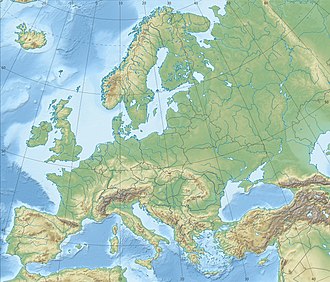SS Empire Conyngham
| History | |
|---|---|
| Name |
|
| Owner |
|
| Operator |
|
| Port of registry | |
| Builder | Neptun AG |
| Launched | 1899 |
| Out of service | 20 June 1949 |
| Identification | |
| Fate | Scuttled |
| General characteristics | |
| Type | Cargo ship |
| Tonnage | |
| Length | 241 ft 5 in (73.58 m) |
| Beam | 36 ft 1 in (11.00 m) |
| Depth | 16 ft 9 in (5.11 m) |
| Installed power | Triple expansion steam engine |
| Propulsion | Screw propeller |
Empire Conyngham was a 1,408 GRT
Description
The ship was built in 1899 by Neptun AG, Rostock.[1]
The ship was 241 feet 5 inches (73.58 m) long, with a beam of 36 feet 1 inch (11.00 m) and a depth of 16 feet 9 inches (5.11 m). She was assessed at 1,501 GRT, 895 NRT.[2]
The ship was propelled by a
History
Marie was built for the Flensburger Dampfschiff Gesellschaft,
On 8 June 1941, Gauja was captured by the Kriegsmarine in the Baltic Sea. She was renamed Friedrich and operated by Otto Wiggers, Rostock. Friedrich was captured by the Allies in May 1945. She was passed to the MoWT and renamed Empire Conyngham.[1] Her port of registry was changed to London and the Code Letters GKWN were allocated.[5] On 18 June 1949, Empire Conyngham departed Dartmouth, Devon with a cargo of obsolete bombs. She was escorted by HMS Burghead Bay. On 20 June, she was scuttled in the Bay of Biscay (47°52′N 8°51′W / 47.867°N 8.850°W).[6]
References
- ^ ISBN 1-85044-275-4.
- ^ a b c "LLOYD'S REGISTER, STEAMERS AND MOTORSHIPS" (PDF). Plimsoll Ship Data. Retrieved 3 November 2010.
- ^ "EMPIRE - C". Mariners. Retrieved 3 November 2010.
- ^ "LLOYD'S REGISTER, NAVIRES A VAPEUR ET A MOTEURS" (PDF). Plimsoll Ship Data. Retrieved 3 November 2010.
- ^ "LLOYD'S REGISTER, NAVIRES A VAPEUR ET A MOTEURS" (PDF). Plimsoll Ship Data. Retrieved 3 November 2010.
- ^ "HMS BURGHEAD BAY (K 622) - Bay-class Frigate". Naval History. Retrieved 3 November 2010.

